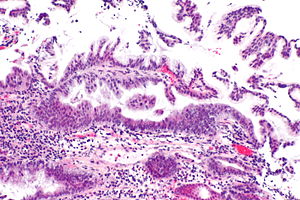Foveolar type dysplasia
Jump to navigation
Jump to search
| Foveolar type dysplasia | |
|---|---|
| Diagnosis in short | |
 Foveolar dysplasia of the duodenum. H&E stain. | |
|
| |
| Synonyms | type 2 dysplasia, foveolar dysplasia, foveolar/hyperplastic dysplasia |
| LM DDx | benign foveolar epithelium, gastric heterotopia (if not stomach), benign ampullary epithelium, hyperplastic polyp |
| Site | stomach, duodenum (esp. ampulla of Vater), esophagus |
|
| |
| Syndromes | familial adenomatous polyposis |
|
| |
| Prevalence | not common |
| Other | may be subtle |
Foveolar type dysplasia, also foveolar dysplasia, is a form of dysplasia that arises from the foveolar cells, typically seen in the stomach. It may be subtle to unaccustomed eyes.
It is also described as non-adenomatous dysplasia, type 2 dysplasia and foveolar/hyperplastic type dysplasia.[1]
General
- Precursor to adenocarcinoma.
Microscopic
Features:
- Tall columnar cells with basal nuclei in a villiform architecture.[1]
- +/-Proliferative activity - mitotic figures.
DDx:
- Benign foveolar epithelium - seen in stomach and ampulla of Vater.
- Gastric heterotopia.
- Hyperplastic polyp.
Images
www:
IHC
Features:[2]
- p53 +ve.
- Ki-67 increased staining in ~100% of cases.
Sign out
A. Polyp, Stomach, Biopsy or Polypectomy: - Polypoid fragment of gastric body type mucosa with low-grade DYSPLASIA, foveolar type, see comment. - NEGATIVE for Helicobacter-like organisms. - NEGATIVE for intestinal metaplasia. - NEGATIVE for evidence of malignancy. Comment: The sections show foveolar type epithelium with proliferation and hyperchromasia extending to the surface. A p53 and Ki-67 show diffuse staining in the abnormal epithelium. The architectural complexity is mild in the abnormal epithelium. Deepers were cut (x3); these are non-contributory.
See also
References
- ↑ 1.0 1.1 1.2 Brown, IS.; Whiteman, DC.; Lauwers, GY. (Jun 2010). "Foveolar type dysplasia in Barrett esophagus.". Mod Pathol 23 (6): 834-43. doi:10.1038/modpathol.2010.59. PMID 20228780.
- ↑ Testino G, Cornaggia M, Ferrando V (2007). "Low- and high-grade non-invasive gastric neoplasia (formerly dysplasia): cytological differentiation (gastro-entero-pancreatic antigens) in association with p53 pattern expression". Hepatogastroenterology 54 (73): 1–3. PMID 17419219.

